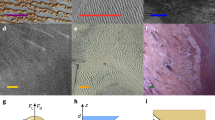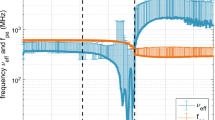Abstract
One of the spectacular discoveries of the Cassini spacecraft was the plume of water vapour and icy particles (dust) originating near the south pole of Saturn’s moon Enceladus1,2,3,4,5. The data imply considerably smaller velocities for the grains2,5,6 than for the vapour4,7, which has been difficult to understand. The gas and dust are too dilute in the plume to interact, so the difference must arise below the surface. Here we report a model for grain condensation and growth in channels of variable width. We show that repeated wall collisions of grains, with re-acceleration by the gas, induce an effective friction, offering a natural explanation for the reduced grain velocity. We derive particle speed and size distributions that reproduce the observed and inferred properties of the dust plume. The gas seems to form near the triple point of water; gas densities corresponding to sublimation from ice at temperatures less than 260 K are generally too low to support the measured particle fluxes2. This in turn suggests liquid water below Enceladus’ south pole.
This is a preview of subscription content, access via your institution
Access options
Subscribe to this journal
Receive 51 print issues and online access
$199.00 per year
only $3.90 per issue
Buy this article
- Purchase on Springer Link
- Instant access to full article PDF
Prices may be subject to local taxes which are calculated during checkout



Similar content being viewed by others
References
Dougherty, M. K. et al. Identification of a dynamic atmosphere at Enceladus with the Cassini magnetometer. Science 311, 1406–1409 (2006)
Spahn, F. et al. Cassini dust measurements at Enceladus and implications for the origin of the E ring. Science 311, 1416–1418 (2006)
Waite, J. H. et al. Cassini ion and neutral mass spectrometer: Enceladus plume composition and structure. Science 311, 1419–1422 (2006)
Hansen, C. J. et al. Enceladus' water vapor plume. Science 311, 1422–1425 (2006)
Porco, C. C. et al. Cassini observes the active south pole of Enceladus. Science 311, 1393–1401 (2006)
Ingersoll, A. P., Porco, C. C., Helfenstein, P. & West, R. A. the Cassini ISS Team. Models of the Enceladus plumes. Bull. Am. Astron. Soc. 38, 508 (2006)
Tian, F., Stewart, A. I. F., Toon, O. B., Larsen, K. W. & Esposito, L. W. Monte Carlo simulations of the water vapor plumes on Enceladus. Icarus 188, 154–161 (2007)
Showalter, M., Cuzzi, J. & Larson, S. Structure and particle properties of Saturn's E ring. Icarus 94, 451–473 (1991)
Nicholson, P. D. et al. Observations of Saturn's ring-plane crossing in August and November 1995. Science 272, 509–516 (1996)
Haff, P. K., Eviatar, A. & Siscoe, G. Ring and plasma: the enigmae of Enceladus. Icarus 56, 426–438 (1983)
Pang, K. D., Voge, C. C., Rhoads, J. W. & Ajello, J. M. The E ring of Saturn and satellite Enceladus. J. Geophys. Res. 89, 9459–9470 (1984)
Kargel, J. S. & Pozio, S. The volcanic and tectonic history of Enceladus. Icarus 119, 385–404 (1996)
Spencer, J. R. et al. Cassini encounters Enceladus: background and the discovery of a south polar hot spot. Science 311, 1401–1405 (2006)
Brown, R. H. et al. Composition and physical properties of Enceladus. Surf. Sci. 311, 1425–1428 (2006)
Spitale, J. N. & Porco, C. C. Association of the jets of Enceladus with the warmest regions on its south-polar fractures. Nature 449, 695–697 (2007)
Kieffer, S. W. et al. A clathrate reservoir hypothesis for Enceladus' south polar plume. Science 314, 1764–1766 (2006)
Gioia, G., Chakraborty, P., Marshak, S. & Kieffer, S. W. Unified model of tectonics and heat transport in a frigid Enceladus. Proc. Natl Acad. Sci. USA 104, 13578–13591 (2007)
Shaw, R. A. & Lamb, D. Experimental determination of the thermal accommodation and condensation coefficients of water. J. Chem. Phys. 111, 10659–10663 (1999)
Batista, E. R., Ayotte, P., Bilic, A., Kay, B. D. & Jonsson, H. What determines the sticking probability of water molecules on ice? Phys. Rev. Lett. 95, 223201 (2005)
Matson, D. L., Castillo, J. C., Lunine, J. & Johnson, T. V. Enceladus' plume: compositional evidence for a hot interior. Icarus 187, 569–573 (2007)
Collins, G. C. & Goodman, J. C. Enceladus' south polar sea. Icarus 189, 72–82 (2007)
Nimmo, F., Spencer, J. R., Pappalardo, R. T. & Mullen, M. E. Shear heating as the origin of the plumes and heat flux on Enceladus. Nature 447, 289–291 (2007)
Viisanen, Y., Strey, R. & Reiss, H. Homogeneous nucleation rates for water. J. Chem. Phys. 99, 4680–4692 (1993)
Juhász, A. & Horányi, M. Saturn's E ring: a dynamical approach. J. Geophys. Res. 107, 1–10 (2002)
Horányi, M., Burns, J. A. & Hamilton, D. P. The dynamics of Saturn's E ring particles. Icarus 97, 248–259 (1992)
Hamilton, D. & Burns, J. Origin of Saturn’s E ring: selfsustained—naturally. Science 264, 550–553 (1994)
Hurford, T. A., Helfenstein, P., Hoppa, G. V., Greenberg, R. & Bills, B. G. Eruptions arising from tidally controlled periodic openings of rifts on Enceladus. Nature 447, 292–294 (2007)
Kempf, S. et al. The E ring in the vicinity of Enceladus I: spatial distribution and properties of the ring particles. Icarus (in the press)
Acknowledgements
We thank M. Burton, P. Krapivsky, H. Salo, T. Spilker, M. Sremčević and F. Tian for discussions. We acknowledge the efforts of the Cassini ISS team in the design and operation of the ISS instrument. This work was supported by Deutsches Zentrum für Luft und Raumfahrt and Deutsche Forschungsgemeinschaft.
Author information
Authors and Affiliations
Corresponding author
Supplementary information
Supplementary Information
This file contains Supplementary Notes with additional references and Supplementary Figures S1-S8 with Legends. (PDF 1970 kb)
Rights and permissions
About this article
Cite this article
Schmidt, J., Brilliantov, N., Spahn, F. et al. Slow dust in Enceladus' plume from condensation and wall collisions in tiger stripe fractures. Nature 451, 685–688 (2008). https://doi.org/10.1038/nature06491
Received:
Accepted:
Issue Date:
DOI: https://doi.org/10.1038/nature06491
This article is cited by
-
Exploration of Enceladus and Titan: investigating ocean worlds’ evolution and habitability in the Saturn system
Experimental Astronomy (2022)
-
Enceladus as a potential oasis for life: Science goals and investigations for future explorations
Experimental Astronomy (2022)
-
Ice-Ocean Exchange Processes in the Jovian and Saturnian Satellites
Space Science Reviews (2020)
-
Key Technologies and Instrumentation for Subsurface Exploration of Ocean Worlds
Space Science Reviews (2020)
-
Circumplanetary Dust Populations
Space Science Reviews (2019)
Comments
By submitting a comment you agree to abide by our Terms and Community Guidelines. If you find something abusive or that does not comply with our terms or guidelines please flag it as inappropriate.



